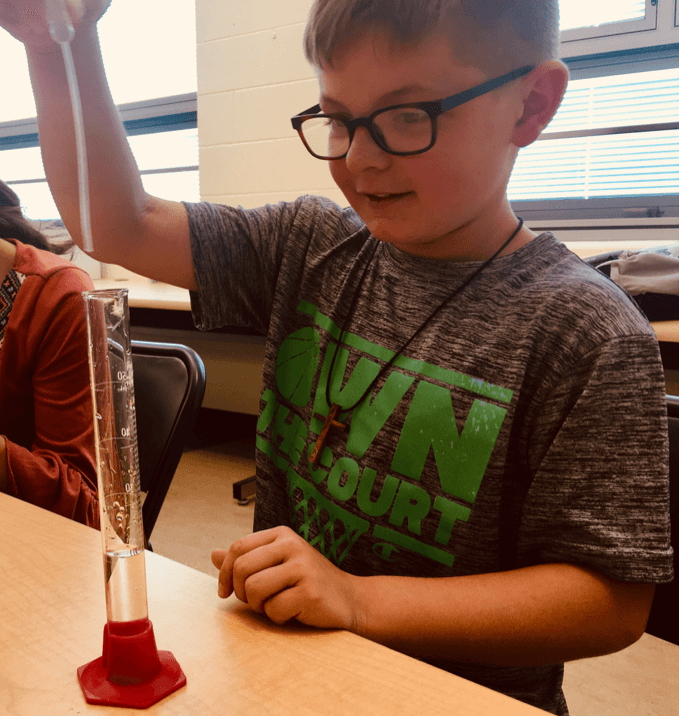By: Meghan Thoreau, OSU Extension Educator
October’s STEM Club
We thought we’d take advantage of the spooky mystery themes of Halloween and challenge our students to become science detectives, experimenting with hands-on activities involving chromatography, perception of vision, and phosphorescent slime chemistry.
Chromatography
The students became CSI lab technicians, tasked with solving a who-done-it pumpkin theft. All that was left at the scene of the crime was a letter demanding cookies! No fingerprints were found, but six suspects were brought in for questioning and all six had different black markers on their person. The marker evidence was tagged and brought to the CSI lab along with the random letter for further analysis. Marker samples were taken and a chromatography test was performed by our young lab technicians.
Chromatography is a laboratory technique for the separation of a mixture (more specifically separation of molecules) and in our case black marker ink molecules. The ink was dissolved in a water solution process of mobile to stationary phase, revealing distinct ink-finger prints for comparative analysis against an ink sample taken from the random note. The students discovered different ink molecules travel at different speeds, causing them to separate and reveal distinct color patterns that could help identify the pumpkin thief from the six suspects.
People don’t often pick up a marker or pen and think of molecules, but ink and paints are made up of atoms and the molecules, like everything, follow rules. Ink and paints follow the standard CPK rule, which is a popular color convention for distinguishing atoms of different chemical elements in molecular modeling (named after the chemists Robert Corey, Linus Pauling, and Walter Koltun). Basically, certain elements are associated with different colors. For example,
- Hydrogen = White
- Oxygen = Red
- Chlorine = Green
- Nitrogen = Blue
- Carbon = Grey
- Sulphur = Yellow
- Phosphorus = Orange
- Other = Varies – mostly Dark Red/Pink/Maroon
PERSISTENCE OF VISION
Persistence of vision refers to the optical illusion that occurs when visual perception of an object does not cease for some time after the rays of light proceeding from it have ceased to enter the eye. The discovery was first discussed in 1824 when an English-Swiss physicist named Peter Mark Roget presented a paper, “Explanation of an Optical Deception in the Appearance of the Spokes of a Wheel when seen through Vertical Apertures” to the Royal Society in London. Shortly after, in 1832, a Belgian physicist Joseph Plateau built a toy that took advantage of the optical illusion trick. (Photo below source: http://streamline.filmstruck.com/2012/01/07/the-persistence-of-persistence-of-vision/)
The toy made images move independently but overlapped them or when placed in a series made them look as if they were walking, running, juggling, dancing. This concept soon laid the foundation for early filmmaking. (Photo below source be: http://1125996089.rsc.cdn77.org/wp-content/uploads/2011/12/persistence-of-vision-transit.jpg)
The students learned how our eyes report basic imaginary back to the brain, or rather how our eyes perceive shapes, their motion, and their relative position from other objects. The students discovered that eyes are not simple windows to the world. Eyes do not see what is, but instead, see approximations.
PHOSPHORESCENT SLIME
The students learned how different objects glow in the dark. First, students learned that heat is a good emitter of light, such as a fire or an old-fashioned light bulb, but heat isn’t always required to make something appear to glow. For example, bedroom glow-in-the-dark stickers, glow sticks, or fireflies do not require heat. The stickers and even certain types of rocks, like the Bologna Stone, require several hours of light to charge them in order to later glow. But glow sticks and fireflies, do not require heat or light, but instead, deal with chemistry where two different elements are mixed together to make a ‘luminescent’ compound.
We talked about phosphorescence and the process in which energy absorbed by a substance is released slowly in the form of light. Unlike the relatively swift reactions in fluorescence, such as those seen in a common fluorescent tube, phosphorescent materials “store” absorbed energy for a longer time, as the processes required to re-emit energy occur less often.
Finally, we let the students become chemists and make their own phosphorescent slime for later glow in the dark fun after the compound was charged by light. The young chemists used measuring devices to concoct their spooky slime recipe.
Make another batch at home with your young chemist:
- Add 20.0 mL of glue to cup
- Add 15.0 mL of water to cup
- STIR!
- Drop of preferred food coloring
- STIR!
- Add a drop of glow in the dark phosphorescence paint
- Add 12.0 mL of BORAX solution
- STIR! It will be runny until you take it out of the cup and start to play with it.
Next month we will be challenging our STEMist in Mind and Body Challenges! Stay tuned to learn more about November’s STEM adventures.
















